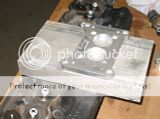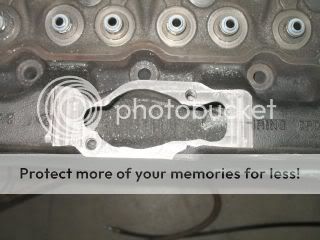Ahh,Gent! I know your of Flemish decent, or else you'd have called it Gand or Ghent!
All your questions were actually answered in
viewtopic.php?f=1&t=70514&p=540842#p540842,but I assume it may have been complicated by the difficult English Dutch language barrier.
All my best friends are of Dutch decent, if you need help in Dutch langage, please call and I'll ask one of them to help. One is a nurse, the other a Bicycle Mechanic. Each has helped me out in the past. My co-worker spent two years in Gent with her husband who is financial supervisor.
Note the following.
Ken's engine has the 4412 500 cfm carb on the later head with the float bowl mounted front ways. Irrespective if its traditional sideways mount, or like it is below, he has a height problem of 4.5 centimeters, about the extra height of a 250 engine over the 200 engine. Stock 200 3.3 short deck is 19,82 centimeters tall from crank to head gasket, stock US 250 4.1 is 24,05centimeters, so the engine height is 4,23 centemeters more. Take 4,5 cm's out, and you have success. '
See below





1.The 250 is a very tall engine, and the 69 Mustang got major engine mount changes to even fit the 250 into the 69 Mustang turret. Kens1970 Mustang has the same limitations. I know all you want is the hood to close over the Holley 500 cfm carb. What your asking is difficult, but not impossible. To do it, you have to machine off the air horn, and run a remote filter to the existing hood scoop.
The air horn gets machined off like what was done on the factory Six Pack Mopar carbs
If the 2-bbl without an air horn is placed where the stock 2-bbl its is now, you'll get 4.5 cm of height off the carb, and be able to shut the hood. You can then make a carb base that seals against the underside of the hood, and run a remote filter of the orginal Holley 2-bbl carb base you have.
2. Your stated goal is to just get the carburettor below the hood line. , then its better to cut off the choke horn, and install a Percy's Adjusta Jet,
It just requires the removal of the plastic tang

and have a machinist or model aircraft technician make a linear servo to richen the carb two turns or 9 jet sizes when starting.
Most 250's run a bigger than 60 jet size, which gives a 12.5 or 13.5:1 cruise air:fuel ratio. You then have a servo shift that 2 clockwise turns, and the jet becomes a 69 size, which allows you to get a 9:1 air fuel ratio on start up.
See this and click to enlarge

3. The direct mount conversion method in your case
does not improve hood clearance, as to do that, it depends on the adaptor you have . In your case, the adaptor is as shallow as it can be, and the limiting point is the rocker cover to float bowl. The direct mount conversion method only offers a substantial increase in power and torque, over the two to one (2-1) type carb adaptor which has been evident on all Classic Inlinesdyno tests, not improved hood clearance in your case. It is impossible for a direct mount to liberate the 4 cms needed, as the carb float to rocker cover is the pinch point.
4.I've grown up around all versions of the short and tell deck 200 and 250 engines. I used to ride to kindy as a four year old in a blue 200 XR Falcon station wagon, and learned to drive in an alloy head Falcon 4.1 Utility vehicle. The issue is that because of the weight increase due to engine height, and the need to have a extra strenghth diff and stronger transmission over the early 200, the 250 six is only 9% more powerfull than a 200, revs just as poorly or worse, and uses more fuel, but when modifed correctly, the 4.1 is one of the best engines you can get. Ford USA did no favours to anyone with the 250, and the only glimmer of hope was the changes made to make it the 170 HP 2V 250, and now, the Classic Inlines head. The engine combination with a proper 2-bbl with a log head can still make 205 hp, though. See
Crosley's direct mount Falcon modifications.
viewtopic.php?f=1&t=56639&p=440076#p440076. Can't do 15 sec ET's at 88mph unless you've got 205 hp.

Gene did the same stuff with his 250 Maverick, yet the time taken to make it run as fast has been a lot longer. The point is the 250 is a subborn engine, but treat it right, and its as landmark a long stroke engine as a 455 Pontiac, 455 Oldsmobile, or 292 GMC or Chevy inliner. Those engines above there weight catagory. Ford Australia kept the 250 stroke and almost as tall block because it gets results. The 200 always gets better results when in earlier ligher weight combinations. Each engine has its pros and cons. If I had a Taunas, Cortina, pre 1971 Falcon, a lightweight Aussie XE or XF Falcon I'd have a low deck 200 everytime. If I had a Classic early Mustang, Maverick, Fox body or later X-shell, I'd go 250 everytime. Its up to how much room and weight there is. Those early Falcons were very light,which is why an XR Falcon Wagon can run a little 385 pound 200 engine better than a 470 pound 250.















